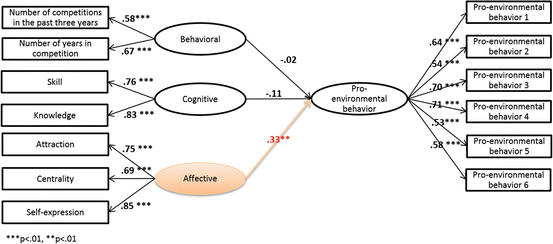Behavioral level
F-value
Multiple comparison
Low (n = 72)
Medium (n = 153)
High (n = 37)
Pro-environmental behavior
4.81
4.61
4.73
1.15
n.s.
Table 1.2
Results of one-way ANOVA for the cognitive dimension
Cognitive level | F-value | Multiple comparison | |||
|---|---|---|---|---|---|
Low (n = 168) | Medium (n = 47) | High (n = 47) | |||
Pro-environmental behavior | 4.66 | 4.80 | 4.91 | 1.67 | n.s. |
Table 1.3
Results of one-way ANOVA for the affective dimension
Affective level | F-value | Multiple comparison | |||
|---|---|---|---|---|---|
Low (n = 28) | Medium (n = 192) | High (n = 44) | |||
Pro-environmental behavior | 4.26 | 4.74 | 5.00 | 6.21** | Low < medium |
Low < high | |||||
In order to further evaluate these results, a structure analysis was used to examine the effects of the three specialization dimensions on pro-environmental behavior. The results indicated that, of the three dimensions that make up specialization, the path coefficient from the affective dimension to pro-environmental behavior was .33, and significant at the 1 % level. This indicates that triathlon participants’ pro-environmental behavior is influenced by the affective dimension of their specialization (model’s goodness of fit, χ2/df = 2.49, GFI = .92, AGFI = .88, CFI = .91, RMSEA = .08) (Fig. 1.1).


Fig. 1.1
Path diagram of specialization and pro-environmental behavior covariance structure analysis
This result suggests that emotional involvement5 in a triathlon affects the participants’ opinion toward pro-environmental behavior. In other words, the likelihood of taking environmentally conscious actions may increase as emotional involvement in the triathlon increases. This conclusion is in agreement with the results of Thapa et al. (2006) and Lee (2011), both of which demonstrated an effect of emotional involvement on pro-environmental behavior. Kollmuss and Agyeman (2002) stated that an emotional tie to nature is also important for fostering awareness of and interest toward the environment. It seems that participants become attached to the place and environment in which the triathlon is held, and begin to feel an emotional tie to nature as their emotional involvement in the triathlon increases, eventually leading them to take pro-environmental actions.
The lack of significance for a relationship between the behavioral dimension and pro-environmental behavior indicates that the frequency of participation in a triathlon does not affect pro-environmental behavior. Presumably, participants, as they continue to compete, become more eager to improve their ability to compete—they want to enter into more competitions and improve their performances—and as a result become more interested in their record as competitor than in the environment in which the competition takes place. The same can be said for the cognitive dimension: the covariance structure analysis showed that the cognitive dimension, although not significant, had a negative effect on pro-environmental behavior. This indicates that a participant’s score for pro-environmental behavior declines as that participant improves their skill and knowledge.
On the other hand, assuming that the three dimensions—behavioral, cognitive, and affective—are correlated, I would expect the participants’ emotional involvement in triathlons to increase as the behavioral and cognitive dimensions increase. However, the results of this study indicate that there is a different relation between the behavioral and cognitive dimensions and pro-environmental behavior. Kuentzel and McDonald (1992) stated that, while an individual who is new to an activity is more likely to commit to an activity and see it as central to their lifestyle when they are new to the activity, that commitment and vision diverges as they become more experienced. In other words, it is conceivable that a participant’s involvement in triathlon becomes diverges once their behavior, skill, and knowledge reach a certain level. This may explain why behavioral and cognitive dimensions had no direct effect on pro-environmental behavior.
Based on the above, I conclude that the behavioral and cognitive dimensions of a triathlon are not related to pro-environmental behavior; only the participants’ emotional involvement in the triathlon can predict pro-environmental behavior.
1.3.2 Case of Trail Running
The next case study concerns trail running participants. Trail running is an athletic sport in which the participant runs through the environment with (1) unpaved roads, (2) hilly mountain paths, (3) vast wilderness landscapes, and (4) obstacles such as mud and tree roots (Japan Trail Running Association n.d.). The Japan Trail Running Association (JTRA), which aims to foster personal health, an understanding of nature, mutual aid, and a spirit of compassion towards others, all through the practice of running in nature, also has regulations for nature conservation. In other words, trail running can be considered a sport that increases its participants’ understanding of nature, because it is deeply connected to the natural environment.
Utilizing a methodology similar to the above-mentioned survey of triathlon participants, I conducted a questionnaire survey of trail running participants (N = 228, RR = 75.7 %), examining the relationship between their emotional involvement in trail running and pro-environmental behaviors. “Emotional involvement” consisted of three factors—attraction, centrality, and self-expression—and 12 items. The synthesis variables were calculated by adding together the score of each item. Participants were classified into either a high- or low-attraction group by using the synthesis variables. A T-test was performed to examine the difference between the high- and low-group of each factor. The results, shown in Tables 1.4, 1.5, and 1.6, indicate that, for all three factors, the two groups had different scores for pro-environmental behaviors, with the high-attraction group scoring higher in all cases.
Table 1.4
T-test for involvement (attraction) and pro-environmental behavior
Attraction | t-value | ||
|---|---|---|---|
Low (n = 77) | High (n = 76) | ||
Pro-environmental behavior | 4.65 | 4.98 | −2.10* |
Table 1.5




T-test for involvement (centrality) and pro-environmental behavior
Stay updated, free articles. Join our Telegram channel

Full access? Get Clinical Tree







